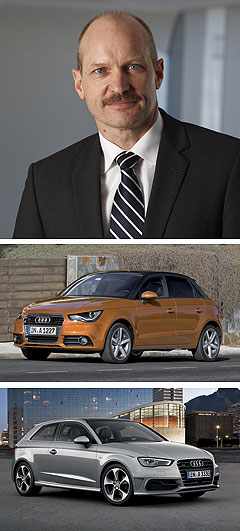Supply will limit Q3 sales
BY BYRON MATHIOUDAKIS | 2nd Apr 2012

Since its launch in Europe in the third quarter of 2011, there have been over 20,000 Q3s sold, with demand now running well ahead of supply.
Audi Australia managing director Uwe Hagen told GoAuto at the national Q3 launch last week the company was trying to address production issues in Germany.
“At the start of production we were looking at 80,000 cars annually, but we can easily increase that to 100,000 units per year,” he said.
“But to truly meet worldwide volumes we need to extend that in the future.” Mr Hagen said the importance of the Q3 in Australia is not only in its potential to steal sales from direct rivals like the BMW X1 and Range Rover Evoque, but also in the model’s ability to conquest buyers from more mainstream brands.
The luxury compact SUV is charged with bringing new faces into Audi’s Australian dealerships.
“From a planning volume next year, the A4 will still be the largest seller for us in Australia,” said Mr Hagen.

“But we have been waiting for a long time for this car.
“The Q3 covers more (customer ground) than something like the Q7 – it has space, you can use it in the city, fit it in the garage and it is easy to park, yet it has all the technology of larger Audi models – therefore for volume it is an important model.
“The other big point is it is an entry-level model that gives us a chance to get someone into our brand who is usually more associated with main volume brands. We now at last have a car that is interesting to him or her, and that it will get them considering our brand. So it is very important for us.” With fuel prices rising, Mr Hagen believes diesels will eventually become the most popular Q3 variants, despite the 2.0-litre TFSI quattro petrol model being earmarked as the highest seller in the initial stages.
“Three of our engines – and all are diesels – are under the 7.0L/100km (LCT luxury car tax threshold) so buyers don’t have to pay the LCT – and this has a massive influence within the premium sector. So my personal assumption is that the diesel may be the bestseller.” Mr Hagen said the smallest vehicles in Audi’s SUV and passenger car model ranges – the Q3 and the A1 Sportback due mid-year – will have the biggest sales growth for the company in Australia over the next two years.
“We are bringing two models that will bring us real volume – the Q3 and the A1 Sportback. Their biggest importance is that both will bring new customers to our brand.” Along with growing variations of the A1 and Q3, Audi will introduce the all-new third-generation A3 small car next year. It will eventually be offered in four-door sedan as well as more traditional hatchback variations, while a convertible may again be on the agenda.
The A2 electric vehicle – which may use the long-wheelbase version of the NSF platform underpinning the Volkswagen Up – will further bolster Audi’s small car presence in Australia, but not before 2015.